电流反馈放大器
电压反馈放大器与电流反馈放大器的区别
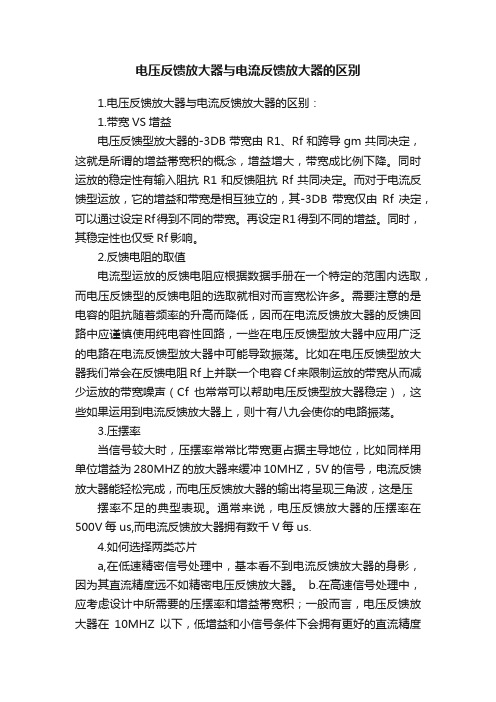
电压反馈放大器与电流反馈放大器的区别1.电压反馈放大器与电流反馈放大器的区别:1.带宽VS增益电压反馈型放大器的-3DB带宽由R1、Rf和跨导gm共同决定,这就是所谓的增益帯宽积的概念,增益增大,带宽成比例下降。
同时运放的稳定性有输入阻抗R1和反馈阻抗Rf共同决定。
而对于电流反馈型运放,它的增益和带宽是相互独立的,其-3DB带宽仅由Rf决定,可以通过设定Rf得到不同的带宽。
再设定R1得到不同的增益。
同时,其稳定性也仅受Rf影响。
2.反馈电阻的取值电流型运放的反馈电阻应根据数据手册在一个特定的范围内选取,而电压反馈型的反馈电阻的选取就相对而言宽松许多。
需要注意的是电容的阻抗随着频率的升高而降低,因而在电流反馈放大器的反馈回路中应谨慎使用纯电容性回路,一些在电压反馈型放大器中应用广泛的电路在电流反馈型放大器中可能导致振荡。
比如在电压反馈型放大器我们常会在反馈电阻Rf上并联一个电容Cf来限制运放的带宽从而减少运放的带宽噪声(Cf也常常可以帮助电压反馈型放大器稳定),这些如果运用到电流反馈放大器上,则十有八九会使你的电路振荡。
3.压摆率当信号较大时,压摆率常常比带宽更占据主导地位,比如同样用单位增益为280MHZ的放大器来缓冲10MHZ,5V的信号,电流反馈放大器能轻松完成,而电压反馈放大器的输出将呈现三角波,这是压摆率不足的典型表现。
通常来说,电压反馈放大器的压摆率在500V每us,而电流反馈放大器拥有数千V每us.4.如何选择两类芯片a,在低速精密信号处理中,基本看不到电流反馈放大器的身影,因为其直流精度远不如精密电压反馈放大器。
b.在高速信号处理中,应考虑设计中所需要的压摆率和增益帯宽积;一般而言,电压反馈放大器在10MHZ以下,低增益和小信号条件下会拥有更好的直流精度和失真性能;而电流反馈放大器在10MHZ以上,高增益和大信号调理中表现出更好的带宽和失真度。
当下面两种情况出现一种时,你就需要考虑一下选择电流反馈放大器:1,噪声增益大于4;2,信号频率大于10MHZ。
反馈放大电路

将放大电路输出端的信号(电压或电流)的一部分或全部 通过反馈网络引回到输入端,与输入信号迭加的过程称为反馈。
具有反馈的放大电路称为反馈放大电路(闭环放大电路)。判 断是否存在反馈,就是要分析电路是否存在反馈通路.
5.1.1 反馈的基本概念和分类
直流反馈和交流反馈 直流反馈
1 F
在深度负反馈情况下,闭环 增益几乎只取决于反馈系数,若
反馈网络是纯阻性网络,F是一 个稳定的常数,Af 将十分稳定。
增益稳定性: 开环增益相对变化量与闭环
增益相对变化量的比值.
dAf Af
11AF
dA A
该式表明,引入负反馈后闭 环增益的相对变化量是开环增益 相对变化量的 1/(1 AF)。
可见,闭环电压增益变化很小,引入负反馈增加了增益的稳定性。
Xid
AXid FAXid
Af
A 1 AF
反馈放大电路的源增益:
Asf
Xo Xs
KAf
5.1.4 反馈放大电路的基本方程式
反馈深度
Af
A 1 AF
反馈放大电路的基本方程式
负反馈放大电路的 1 AF愈大,闭环增益 Af 下降的愈多, 因此 1 AF是衡量电路反馈程度的重要指标,令
D 1 AF
则 D 1 AF 称为反馈深度。
电子电路基础
Electronic Circuit Foundation
第五章 反馈放大电路
第五章 反馈放大电路
反馈在电子技术领域中应用非常广泛。电子设备中经常采用反 馈改善电路的性能。
无反馈的放大电路称为开环放大电路,有反馈的放大电路称为
闭环放大电路。
实际被放大信号 开环
迭加
模拟电路电流反馈放大器

模拟电路电流反馈放大器电流反馈放大器是一种重要的模拟电路,其作用是将输入电流信号放大,并以输出电流的形式进行反馈控制。
本文将介绍电流反馈放大器的基本原理、特点以及应用领域。
一、基本原理电流反馈放大器是通过控制输出电流来实现放大的,与电压反馈放大器相比,具有更高的带宽和更好的线性度。
其基本原理可以概括为以下几个方面:1. 输入电流:电流反馈放大器的输入为电流信号,可以是直流电流或交流电流。
输入电流经过输入端的电流源,并经过输入电阻进入放大电路。
2. 放大电路:放大电路通常由一个或多个晶体管构成,其中晶体管是最常用的放大元件。
输入电流经过放大电路,经过晶体管的放大作用后得到输出电流。
3. 反馈控制:输出电流经过反馈网络,形成反馈回路。
反馈网络可以根据输出电流调节输入电流,以达到对放大倍数、带宽和线性度的控制。
二、特点电流反馈放大器具有以下几个特点:1. 高带宽:由于采用电流反馈方式,电流反馈放大器的带宽通常比电压反馈放大器更宽,适用于高频信号的放大。
2. 低失真:电流反馈放大器的线性度较好,能够提供较低的失真度,使得放大后的信号更加准确。
3. 稳定性好:电流反馈放大器具有较好的温度稳定性和频率稳定性,不会因外界因素的变化导致放大性能的下降。
三、应用领域电流反馈放大器在各个领域都有广泛的应用,其中一些典型的应用包括以下几个方面:1. 通信系统:电流反馈放大器常用于通信系统中的信号放大环节,如射频放大器、低噪声放大器等。
2. 音频放大器:电流反馈放大器在音频放大器中得到广泛应用,能够提供高保真度的音频放大效果。
3. 传感器信号放大:对于小信号传感器输出的微弱电流进行放大,电流反馈放大器能够提供较高的灵敏度和精度。
4. 仪器仪表:在仪器仪表中,电流反馈放大器可以用于测量小电流信号或进行精确放大。
总结电流反馈放大器作为一种重要的模拟电路,在各个领域都有广泛的应用。
其通过控制输出电流来实现对输入电流的放大,并具有高带宽、低失真和较好的稳定性等特点。
针对高速应用的电流反馈运算放大器
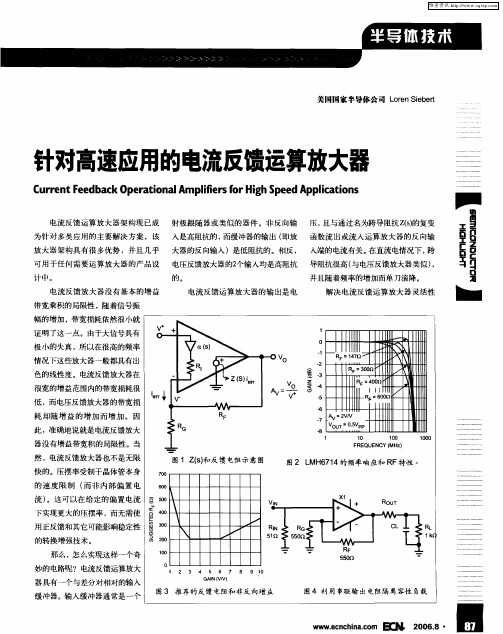
、『. nh a o 日 I,e ci . r C ,I c n cn 、, I 、
20. 06 8・
■
维普资讯
m
另 -
问题的关键在 于可调带宽和 可调稳定 欧姆处 ,可以看到频率 响应正好达到 架 构 和 电 压 反 馈 架 构 的 主 要 区 别 。 电 性。 因为反馈 电阻值会改变 放大器的 最大值。 曲线还具有最大带宽。 电 流反馈放大 器不能 同短 接到反 向输 入 该 将
与器件 的小信号带 宽很 接近的大信号 益 ,而 且还具有 可与峰值频率响应相 可以根据情况 灵活选 用电阻。数据表 带宽 。 更好 的是 , 该带宽在宽增益范围 媲 美的带宽。因此 , 实现 了很高的稳定 中的推荐值是用于生 成性 能列表 中规 内被大量保留。 并且 , 因为 固有的高线 性 , 而并未损耗大量带宽。 如果应用只 定的指标和 曲线的值 。 性 度 ,所以也可 以在高频率情况下获 需 5 或 6 O 0MHz 的带宽 ( 高于该值就会 得低失真和大信号 。
低 了运算放大 器的闭环互 阻抗 ,并随
由于放大 器的A 特性部分取决于 供出色 的信号保真度。 C 反馈 电阻 ,所 以能够针对各个独特 的
同一器件的数据表如 图3 所示。 给 着增益的增加而 开始限制带宽 。在 增
应用调整放大 器。降低 反馈 电阻的值 定非反 向增 益条件下建 议使 用的反馈 益为8 的情况下 , 反馈电阻重新回 ̄2 5 17 能增加环路增益。 低增益下 , 反馈 电阻 电阻如 图所示。在增益为 2 的情况下, 欧姆 。一旦 不能通过降低反馈 电阻来 会设成较高 的值 ,以便保持 高稳定性 推荐使用的反馈 电阻为3 0 0 欧姆 , 这样 增加增 益 ,就得牺牲带宽来获 得较 高 的增益 ,并 且电流反馈放大 器的运行 和最大带宽 。 着增益的增加 , 随 环路增 可获得 最佳的增益平坦度 、稳 定时 间
四种负反馈电路的特点
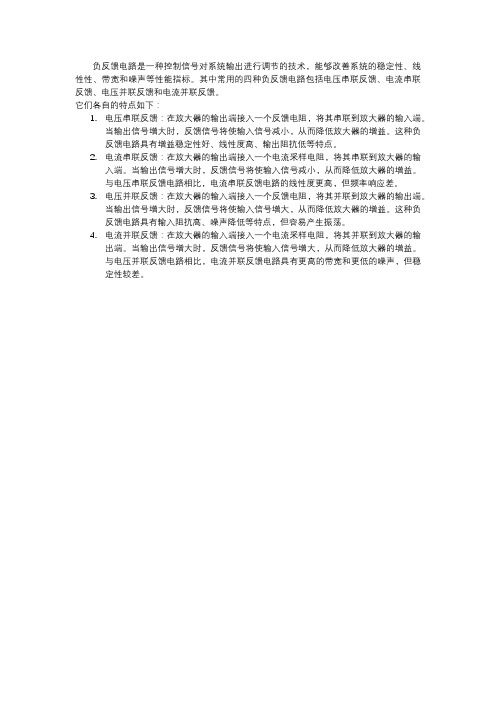
负反馈电路是一种控制信号对系统输出进行调节的技术,能够改善系统的稳定性、线性性、带宽和噪声等性能指标。
其中常用的四种负反馈电路包括电压串联反馈、电流串联反馈、电压并联反馈和电流并联反馈。
它们各自的特点如下:
1.电压串联反馈:在放大器的输出端接入一个反馈电阻,将其串联到放大器的输入端。
当输出信号增大时,反馈信号将使输入信号减小,从而降低放大器的增益。
这种负
反馈电路具有增益稳定性好、线性度高、输出阻抗低等特点。
2.电流串联反馈:在放大器的输出端接入一个电流采样电阻,将其串联到放大器的输
入端。
当输出信号增大时,反馈信号将使输入信号减小,从而降低放大器的增益。
与电压串联反馈电路相比,电流串联反馈电路的线性度更高,但频率响应差。
3.电压并联反馈:在放大器的输入端接入一个反馈电阻,将其并联到放大器的输出端。
当输出信号增大时,反馈信号将使输入信号增大,从而降低放大器的增益。
这种负
反馈电路具有输入阻抗高、噪声降低等特点,但容易产生振荡。
4.电流并联反馈:在放大器的输入端接入一个电流采样电阻,将其并联到放大器的输
出端。
当输出信号增大时,反馈信号将使输入信号增大,从而降低放大器的增益。
与电压并联反馈电路相比,电流并联反馈电路具有更高的带宽和更低的噪声,但稳
定性较差。
第5章放大器中的负反馈

画反馈网络,求反馈系数
负反馈的分析,一定要满足单向化条件,画反馈网络时,要 消除输入信号通过反馈网络的直通效应。 画法: 将反馈放大器的输入端短接(对并联反馈)或开路(对串联 反馈)。
反馈系数的求法:
输出信号通过反馈网络产生的反馈信号,它们的比值就 是反馈系数。
A 1 1 k f A k f
串联反馈 Rif 并联反馈 Rif 0
电压反馈 电流反馈
Rof 0 Rof
vO 1 Avf vi k fv vO 1 Arf ii k fg
iO 1 Aif ii k f i
iO 1 Agf vi k f r
电流反馈: 输出端串联连接
电压取样 . Vo 电流取样 . Vo A . Xf . Io RL
A . Xf
RL
kf (a) VCC 反馈支路 Rf vi RE (c) RC
kf (b) VCC RC vi vo . Ie Rf RE (d)
vo
反馈支路
串联反馈
. Ii + . Vi - Rif - . Vf + kf (a) + . V′i - Rf A + . Vi - Rif
VCC
电压并联负反馈
VCC R2 R1 C1 + + b1 + T1 . e1 v′i + . R3 vf c1 R5 c2 + T2 RL R4 R6 + C2 反馈网络 vo + C3 +
. vi
电压串联负反馈
VCC R2 c1 R1 + b1 . . ii i′i . if + T1 e1 + R3 CE e2 R4 + + CC c2 T2 RL R5 Rof R6 反馈网络 . vo +
电路中的放大器有哪些分类

电路中的放大器有哪些分类在电路中,放大器是一种常见的电子设备,用于增加信号的幅度,从而提供更强的输出。
放大器可以根据其工作原理和设计特点进行分类。
本文将介绍几种常见的电路中的放大器分类。
1. 按照工作原理分类:放大器可以根据其工作原理分为线性放大器和非线性放大器。
1.1 线性放大器:线性放大器是指输出信号的幅度与输入信号的幅度成正比,而且输出信号不会发生失真。
常见的线性放大器有:- 电压放大器(Voltage Amplifier):将输入电压信号放大,输出为电压信号。
- 电流放大器(Current Amplifier):将输入电流信号放大,输出为电流信号。
- 功率放大器(Power Amplifier):将输入信号放大到更高的功率水平。
1.2 非线性放大器:非线性放大器是指输出信号的幅度与输入信号的幅度存在非线性关系,输出信号可能发生失真。
常见的非线性放大器有:- 压控放大器(Voltage-Controlled Amplifier):输出信号的幅度受控制电压的变化而变化。
- 流控放大器(Current-Controlled Amplifier):输出信号的幅度受控制电流的变化而变化。
- 反馈放大器(Feedback Amplifier):通过对输出信号进行反馈控制来实现放大功能。
2. 按照放大器的频率范围分类:放大器也可以根据其工作频率范围进行分类,常见的分类有低频放大器、中频放大器和射频放大器。
2.1 低频放大器:低频放大器主要用于放大低频信号,其频率范围一般在几赫兹(Hz)到几千赫兹(kHz)之间。
2.2 中频放大器:中频放大器广泛应用于无线通信和广播领域,其频率范围通常在几千赫兹(kHz)到几百兆赫兹(MHz)之间。
2.3 射频放大器:射频放大器主要用于无线通信和雷达等应用中,其工作频率范围一般在几百兆赫兹(MHz)到几十吉赫兹(GHz)之间。
3. 按照放大器的类型分类:另外,根据放大器的性质和应用领域,还可以将放大器分为几类,如以下几个例子所示:3.1 差分放大器(Differential Amplifier):差分放大器是一种常见的放大器电路,具有良好的抗干扰性能和共模抑制能力,常用于模拟信号的放大。
电压反馈和电流反馈运算放大器的比较
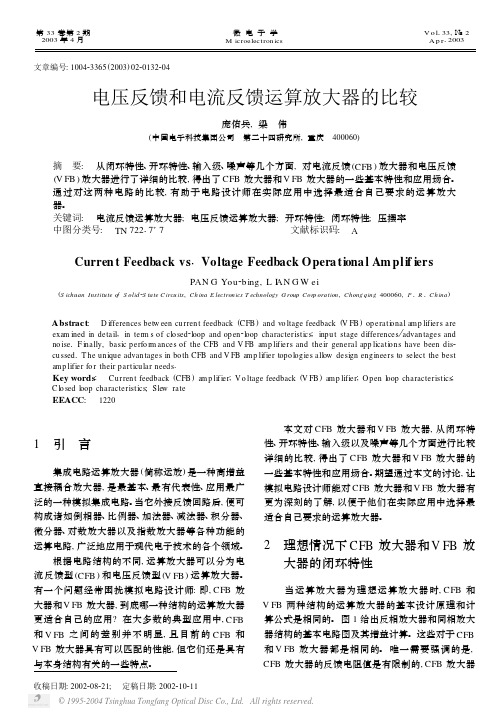
阻 R 2 和内部电路 C P 决定, 而与增益设置电阻 R 1 无 体管匹配, 将不会产生失调电压。
关。 因此, CFB 放大器适用于带宽可编程放大器。
两个输入端是两个晶体管的基极。 虽然基极电
由(10) 式还可以看出, 对于 CFB 放大器, 如果 流 (偏置电流) 的绝对大小会随工艺及温度的变化而
(S ichuan Institu te of S olid 2S ta te C ircu its, C h ina E lectron ics T echnology G roup C orp ora tion, C hong qing 400060, P 1 R 1 C h ina)
Abstract: D ifferences betw een cu rren t feedback (CFB ) and vo ltage feedback (V FB ) op erational am p lifiers are
V o l133, № 2 A p r12003
文章编号: 100423365 (2003) 0220132204
电压反馈和电流反馈运算放大器的比较
庞佑兵, 梁 伟
(中国电子科技集团公司 第二十四研究所, 重庆 400060)
摘 要: 从闭环特性、开环特性、输入级、噪声等几个方面, 对电流反馈 (CFB ) 放大器和电压反馈 (V FB ) 放大器进行了详细的比较, 得出了 CFB 放大器和 V FB 放大器的一些基本特性和应用场合。 通过对这两种电路的比较, 有助于电路设计师在实际应用中选择最适合自己要求的运算放大 器。
CFB 放大器的开环跨导增益 Z (s) 均为无穷大。 因 此, 对于同相放大器, 其电路的理想传输特性推导如 下:
放大电路中的反馈课件2
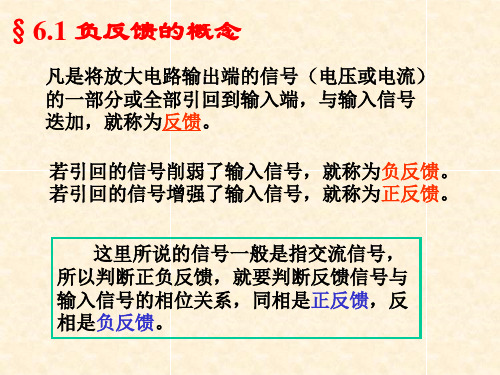
Rf RE2
uF
uo
电流并联负反馈。对直流也起作用,可以稳 定静态工作点。
二、负反馈放大电路的放大倍数
放大电路的开 环放大倍数
A
X o X id
反馈网络的 反馈系数
F
X f X o
放大电路的闭 环放大倍数
A
f
X o X i
由于 X id X i X f
Af
X o X i
A X id X id X f
解:
根据瞬
时极性
⊕
法判断
••
I
i
⊕
I
'
i
○
○
•
If
反馈信号和输入信号加于 输入回路同一点时,瞬时
极性相反是负反馈。
⊕ ○
★输入信号与反馈信号是并联的形式,所以是并联负反馈。 ★反馈信号取自与输出电流,所以是电流负反馈。
电流并联负反馈
例4:
试分析该电路存在的反馈,并判断其反馈组态。
解:
根据瞬时极
性法判断
性
反馈信号和输入信号加于输入回路两点时,瞬时极
法 性相同的为负反馈,瞬时极性相反的是正反馈。
对三极管来说这两点是基极和发射极,对运算放大器
来说是同相输入端和反相 输入端。
以上输入信号和反馈信号的瞬时极性都是指对地 而言,这样才有可比性。
电电压压串串联联负负反反馈馈
Rg
串联负反馈
输入回路Vg
A A ⊕
反馈框图:
实际被放大信号
叠加
输入
±
放大器
反馈
信号 反馈网络
开环 输出
闭环
取+ 加强输入信号 正反馈 用于振荡器
[知识链接一] 反馈放大器的基本知识 (2)
![[知识链接一] 反馈放大器的基本知识 (2)](https://img.taocdn.com/s3/m/b9a0d875b84ae45c3b358cd4.png)
A 当xf与xi同相时,xia相对于xi得到 (│xia│=│xi│+│xf│),此 时的反馈称为正反 馈;当xf与xi反相时,xia相对于xi被削弱 (│xia│=│xi│-│xf│),这种反馈称为负反馈。
4、环路增益 AF(AF= xf/ xia)
|A| | A | (1)若AF<0,即xf与xia或xi反相,则有 | A f | 1 | AF |
3、电压/电流反馈的判别
短路反馈放大器的输出端或短路负载RL(uo=0)。若反馈信 号随之消失,则说明反馈信号与电路的输出电压成正比,应为电 压反馈;否则,为电流反馈。 也可取走负载(io=0),若反馈信号随之消失,则说明反馈 信号与电路的输出电流成正比,应为电流反馈;否则,为电压反 馈。
4、反馈极性的判别
2、按输出电路型式分为电压反馈与电流反 馈
反馈放大器的两种输出电路型式
若将电路的输出电压作为反馈网络的输入信号,则为电 压反馈,此时反馈信号与电路的输出电压成正比;若将 电路的输出电流作为反馈网络的输入信号,则为电流反 馈,此时的反馈信号与电路的输出电流成正比。
三、反馈类型的判别 1、直/交流反馈的判别
(4) 若AF>1,此时xf与xia或xi同相,且xf>xia,则将形成 增幅振荡。
二、反馈放大器的电路类型
含有单环反馈放大器的整个电路,可用下图所示的框图表示:
ii
信 号 源 +
iia ui
Io
基本放大器 A 取样 网络
-
比较 网络
uia
+
-
uo
+
-
负载
-u + f
if
反馈网络 F
根据反馈放大器在输入回路中的信号比较方式以及在输出 回路中反馈网络的信号取样方式,可将反馈分为串联/并联反 馈以及电压/电流反馈,组合起来有四种类型:电压串联反馈、 电流串联反馈、电压并联反馈和电流并联反馈。
运放型号大全(包括电流模)

AD824 JFET输入,单电源,低电压,低功耗,精密四运算放大器MC33171 单电源,低电压,低功耗运算放大器AD826 低功耗,宽带,高速双运算放大器MC33172 单电源,低电压,低功耗双运算放大器AD827 低功耗,高速双运算放大器MC33174 单电源,低电压,低功耗四运算放大器AD828 低功耗,宽带,高速双运算放大器MC33178 大电流,低功耗,低噪音双运算放大器AD844 电流反馈型,宽带,高速运算放大器MC33179 大电流,低功耗,低噪音四运算放大器AD846 电流反馈型,高速,精密运算放大器MC33181 JFET输入,低功耗运算放大器AD847 低功耗,高速运算放大器MC33182 JFET输入,低功耗双运算放大器AD8531 COMS单电源,低功耗,高速运算放大器MC33184 JFET输入,低功耗四运算放大器AD8532 COMS单电源,低功耗,高速双运算放大器MC33201 单电源,大电流,低电压运算放大器AD8534 COMS单电源,低功耗,高速四运算放大器MC33202 单电源,大电流,低电压双运算放大器AD9617 低失真,电流反馈型,宽带,高速,精密运算放大器MC33204 单电源,大电流,低电压四运算放大器AD9631 低失真,宽带,高速运算放大器MC33272 单电源,低电压,高速双运算放大器AD9632 低失真,宽带,高速运算放大器MC33274 单电源,低电压,高速四运算放大器AN6550 低电压双运算放大器MC33282 JFET输入,宽带,高速双运算放大器AN6567 大电流,单电源双运算放大器MC33284 JFET输入,宽带,高速四运算放大器AN6568 大电流,单电源双运算放大器MC33502 BIMOS,单电源,大电流,低电压,双运算放大器BA718 单电源,低功耗双运算放大器MC34071A 单电源,高速运算放大器BA728 单电源,低功耗双运算放大器MC34072A 单电源,高速双运算放大器CA5160 BIMOS,单电源,低功耗运算放大器MC34074A 单电源,高速四运算放大器CA5260 BIMOS,单电源双运算放大器MC34081 JFET输入,宽带,高速运算放大器CA5420 BIMOS,单电源,低电压,低功耗运算放大器MC34082 JFET输入,宽带,高速双运算放大器CA5470 BIMOS单电源四运算放大器MC34084 JFET输入,宽带,高速四运算放大器CLC400 电流反馈型,宽带,高速运算放大器MC34181 JFET输入,低功耗运算放大器CLC406 电流反馈型,低功耗,宽带,高速运算放大器MC34182 JFET输入,低功耗双运算放大器CLC410 电流反馈型,高速运算放大器MC34184 JFET输入,低功耗四运算放大器CLC415 电流反馈型,宽带,高速四运算放大器MC35071A 单电源,高速运算放大器CLC449 电流反馈型,宽带,高速运算放大器MC35072A 单电源,高速双运算放大器CLC450 电流反馈型,单电源,低功耗,宽带,高速运算放大器MC35074A 单电源,高速四运算放大器CLC452 单电源,电流反馈型,大电流,低功耗,宽带,高速运算放大器MC35081 JFET输入,宽带,高速运算放大器CLC505 电流反馈型,高速运算放大器MC35082 JFET输入,宽带,高速双运算放大器EL2030 电流反馈型,宽带,高速运算放大器MC35084 JFET输入,宽带,高速四运算放大器EL2030C 电流反馈型,宽带,高速运算放大器MC35171 单电源,低电压,低功耗运算放大器EL2044C 单电源,低功耗,高速运算放大器MC35172 单电源,低电压,低功耗双运算放大器EL2070 电流反馈型,宽带,高速运算放大器MC35174 单电源,低电压,低功耗四运算放大器EL2070C 电流反馈型,宽带,高速运算放大器MC35181 JFET输入,低功耗运算放大器EL2071C 电流反馈型,宽带,高速运算放大器MC35182 JFET输入,低功耗双运算放大器EL2073 宽带,高速运算放大器MC35184 JFET输入,低功耗四运算放大器EL2073C 宽带,高速运算放大器MM6558 低电压,低失调电压,精密双运算放大器EL2130C 电流反馈型,宽带,高速运算放大器MM6559 低电压,低失调电压,精密双运算放大器EL2150C 单电源,宽带,高速运算放大器MM6560 低电压,低失调电压,精密双运算放大器EL2160C 电流反馈型,宽带,高速运算放大器MM6561 低功耗,低电压,低失调电压,精密双运算放大器EL2165C 电流反馈型,宽带,高速,精密运算放大器MM6564 单电源,低电压,低功耗,低失调电压,精密双运算放大器EL2170C 单电源,电流反馈型,低功耗,宽带,高速运算放大器MM6572 低噪音,低电压,低失调电压,精密双运算放大器EL2175C 电流反馈型,宽带,高速,精密运算放大器NE5230 单电源,低电压运算放大器EL2180C 单电源,电流反馈型,低功耗,宽带,高速运算放大器NE5512 通用双运算放大器EL2224 宽带,高速双运算放大器NE5514 通用四运算放大器EL2224C 宽带,高速双运算放大器NE5532 低噪音,高速双运算放大器EL2232 电流反馈型,宽带,高速双运算放大器NE5534 低噪音,高速运算放大器EL2232C 电流反馈型,宽带,高速双运算放大器NJM2059 通用四运算放大器EL2250C 单电源,宽带,高速双运算放大器NJM2082 JFET输入,高速双运算放大器EL2260C 电流反馈型,宽带,高速双运算放大器NJM2107 低电压,通用运算放大器EL2270C 单电源,电流反馈型,低功耗,宽带,高速双运算放大器NJM2112 低电压,通用四运算放大器EL2280C 单电源,电流反馈型,低功耗,宽带,高速双运算放大器NJM2114 低噪音双运算放大器EL2424 宽带,高速四运算放大器NJM2115 低电压,通用双运算放大器EL2424C 宽带,高速四运算放大器NJM2119 单电源,精密双运算放大器EL2444C 单电源,低功耗,高速四运算放大器NJM2122 低电压,低噪音双运算放大器EL2450C 单电源,宽带,高速四运算放大器NJM2130F 低功耗运算放大器EL2460C 电流反馈型,宽带,高速四运算放大器NJM2132 单电源,低电压,低功耗双运算放大器EL2470C 单电源,电流反馈型,低功耗,宽带,高速四运算放大器NJM2136 低电压,低功耗,宽带,高速运算放大器EL2480C 单电源,电流反馈型,低功耗,宽带,高速四运算放大器NJM2137 低电压,低功耗,宽带,高速双运算放大器HA-2640 高耐压运算放大器NJM2138 低电压,低功耗,宽带,高速四运算放大器HA-2645 高耐压运算放大器NJM2140 低电压双运算放大器HA-2839 宽带,高速运算放大器NJM2141 大电流,低电压双运算放大器HA-2840 宽带,高速运算放大器NJM2147 高耐压,低功耗双运算放大器HA-2841 宽带,高速运算放大器NJM2162 JFET输入,低功耗,高速双运算放大器HA-2842 宽带,高速运算放大器NJM2164 JFET输入,低功耗,高速四运算放大器HA-4741 通用四运算放大器NJM3404A 单电源,通用双运算放大器HA-5020 电流反馈型,宽带,高速运算放大器NJM3414 单电源,大电流双运算放大器HA-5127 低噪音,低失调电压,精密运算放大器NJM3415 单电源,大电流双运算放大器HA-5134 低失调电压,精密四运算放大器NJM3416 单电源,大电流双运算放大器HA-5137 低噪音,低失调电压,高速,精密运算放大器NJM4556A 大电流双运算放大器HA-5142 单电源,低功耗双运算放大器NJM4580 低噪音双运算放大器HA-5144 单电源,低功耗四运算放大器NJU7051 CMOS单电源,低功耗,低电压,低失调电压运算放大器HA-5177 低失调电压,精密运算放大器NJU7052 CMOS单电源,低功耗,低电压,低失调电压双运算放大器HA-5221 低噪音,精密运算放大器NJU7054 CMOS单电源,低功耗,低电压,低失调电压四运算放大器HA-5222 低噪音,精密双运算放大器NJU7061 CMOS单电源,低功耗,低电压,低失调电压运算放大器HA-7712 BIMOS,单电源,低功耗,精密运算放大器NJU7062 CMOS单电源,低功耗,低电压,低失调电压双运算放大器HA-7713 BIMOS,单电源,低功耗,精密运算放大器NJU7064 CMOS单电源,低功耗,低电压,低失调电压四运算放大器HA16118 CMOS单电源,低电压,低功耗双运算放大器NJU7071 CMOS单电源,低功耗,低电压,低失调电压运算放大器AD704 低偏置电流,低功耗,低失调电压,精密四运算放大器MAX430 CMOS单电源运算放大器AD705 低偏置电流,低功耗,低失调电压,精密运算放大器MAX432 CMOS单电源运算放大器AD706 低偏置电流,低功耗,低失调电压,精密双运算放大器MAX4330 单电源,低电压,低功耗运算放大器AD707 低失调电压,精密运算放大器MAX4332 单电源,低电压,低功耗双运算放大器AD708 低失调电压,精密双运算放大器MAX4334 单电源,低电压,低功耗四运算放大器AD711 JFET输入,高速,精密运算放大器MAX473 单电源,低电压,宽带,高速运算放大器AD712 JFET输入,高速,精密双运算放大器MAX474 单电源,低电压,宽带,高速双运算放大器AD713 JFET输入,高速,精密四运算放大器MAX475 单电源,低电压,宽带,高速四运算放大器AD744 JFET输入,高速,精密运算放大器MAX477 宽带,高速运算放大器AD745 JFET输入,低噪音,高速运算放大器MAX478 单电源,低功耗,精密双运算放大器AD746 JFET输入,高速,精密双运算放大器MAX478A 单电源,低功耗,精密双运算放大器AD795 JFET输入,低噪音,低功耗,精密运算放大器MAX479 单电源,低功耗,精密四运算放大器AD797 低噪音运算放大器MAX479A 单电源,低功耗,精密四运算放大器AD8002 电流反馈型,低功耗,宽带,高速双运算放大器MAX480 单电源,低功耗,低电压,低失调电压,精密运算放大器AD8005 电流反馈型,低功耗,宽带,高速双运算放大器MAX492C 单电源,低功耗,低电压,精密双运算放大器AD8011 电流反馈型,低功耗,宽带,高速运算放大器MAX492E 单电源,低功耗,低电压,精密双运算放大器AD8031 单电源,低功耗,高速运算放大器MAX492M 单电源,低功耗,低电压,精密双运算放大器AD8032 单电源,低功耗,高速双运算放大器MAX494C 单电源,低功耗,低电压,精密四运算放大器AD8041 单电源,宽带,高速运算放大器MAX494E 单电源,低功耗,低电压,精密四运算放大器AD8042 单电源,宽带,高速双运算放大器MAX494M 单电源,低功耗,低电压,精密四运算放大器AD8044 单电源,宽带,高速四运算放大器MAX495C 单电源,低功耗,低电压,精密运算放大器AD8047 宽带,高速运算放大器MAX495E 单电源,低功耗,低电压,精密运算放大器AD8055 低功耗,宽带,高速运算放大器MAX495M 单电源,低功耗,低电压,精密运算放大器AD8056 低功耗,宽带,高速双运算放大器MC1458 通用双运算放大器AD8072 电流反馈型,宽带,高速双运算放大器MC1458C 通用双运算放大器AD812 电流反馈型,低电压,低功耗,高速双运算放大器MC33071A 单电源,高速运算放大器AD817 低功耗,宽带,高速运算放大器MC33072A 单电源,高速双运算放大器AD818 低功耗,宽带,高速运算放大器MC33074A 单电源,高速四运算放大器AD820 JFET输入,单电源,低电压,低功耗,精密运算放大器MC33078 低噪音双运算放大器AD822 JFET输入,单电源,低电压,低功耗,精密双运算放大器MC33079 低噪音四运算放大器AD823 JFET输入,单电源,低电压,低功耗,精密,高速双运算放大器MC33102 低功耗双运算放大器HA16119 CMOS单电源,低电压,低功耗双运算放大器NJU7072 CMOS单电源,低功耗,低电压,低失调电压双运算放大器HFA1100 电流反馈型,宽带,高速运算放大器NJU7074 CMOS单电源,低功耗,低电压,低失调电压四运算放大器HFA1120 电流反馈型,宽带,高速运算放大器OP-07 低漂移,精密运算放大器HFA1205 电流反馈型,低功耗,宽带,高速双运算放大器OP-113 BICMOS单电源,低噪音,低失调电压,精密运算放大器HFA1245 电流反馈型,低功耗,宽带,高速双运算放大器OP-150 COMS,单电源,低电压,低功耗ICL7611 CMOS低电压,低功耗运算放大器OP-160 电流反馈型,高速运算放大器ICL7612 CMOS低电压,低功耗运算放大器OP-162 单电源,低电压,低功耗,高速,精密运算放大器ICL7621 CMOS低电压,低功耗双运算放大器OP-177 低失调电压,精密运算放大器ICL7641 CMOS低电压四运算放大器OP-183 单电源,宽带运算放大器ICL7642 CMOS低电压,低功耗四运算放大器OP-184 单电源,低电压,高速,精密运算放大器ICL7650S 稳压器OP-191 单电源,低电压,低功耗运算放大器LA6500 单电源,功率OP放大器OP-193 单电源,低电压,低功耗,精密运算放大器LA6501 单电源,功率OP放大器OP-196 单电源,低电压,低功耗运算放大器LA6510 2回路单电源功率OP放大器OP-200 低功耗,低失调电压,精密双运算放大器"LA6512 高压,功率OP放大器双运算放大器OP-213 BICMOS单电源,低噪音,低失调电压,精密双运算放大器LA6513 高压,功率OP放大器双运算放大器OP-250 COMS,单电源,低电压,低功耗双运算放大器LA6520 单电源,功率OP放大器三运算放大器OP-260 电流反馈型,高速双运算放大器LF356 JFET输入,高速运算放大器OP-262 单电源,低电压,低功耗,高速,精密双运算放大器LF356A JFET输入,高速运算放大器OP-27 低噪音,低失调电压,精密运算放大器LF411 JFET输入,高速运算放大器OP-270 低噪声,低失调电压,精密双运算放大器LF411A JFET输入,高速运算放大器OP-271 精密双运算放大器LF412 JFET输入,高速双运算放大器OP-275 高速双运算放大器LF412A JFET输入,高速双运算放大器OP-279 单电源,大电流双运算放大器LF441 低功耗,JFET输入运算放大器OP-282 JFET输入,低功耗双运算放大器LF441A 低功耗,JFET输入运算放大器OP-283 单电源,宽带双运算放大器LF442 低功耗,JFET输入双运算放大器OP-284 单电源,低电压,高速,精密双运算放大器LF442A 低功耗,JFET输入双运算放大器OP-290 单电源,低功耗,精密双运算放大器LF444 低功耗,JFET输入四运算放大器OP-291 单电源,低电压,低功耗双运算放大器LF444A 低功耗,JFET输入四运算放大器OP-292 BICMOS单电源,通用双运算放大器LM2902 单电源四运算放大器OP-293 单电源,低电压,低功耗,精密双运算放大器LM2904 单电源双运算放大器OP-295 BICMOS低功耗,精密双运算放大器LM324 单电源四运算放大器OP-296 单电源,低电压,低功耗双运算放大器LM358 单电源双运算放大器OP-297 低电压,低功耗,低漂移,精密双运算放大器LM4250 单程控、低功耗运算放大器OP-37 低噪音,低失调电压,高速,精密运算放大器LM607 低失调电压,精密运算放大器OP-400 低功耗,低失调电压,精密四运算放大器LM6118 宽带,高速双运算放大器OP-413 BICMOS单电源,低噪音,低失调电压,精密四运算放大器。
电路中的反馈分类
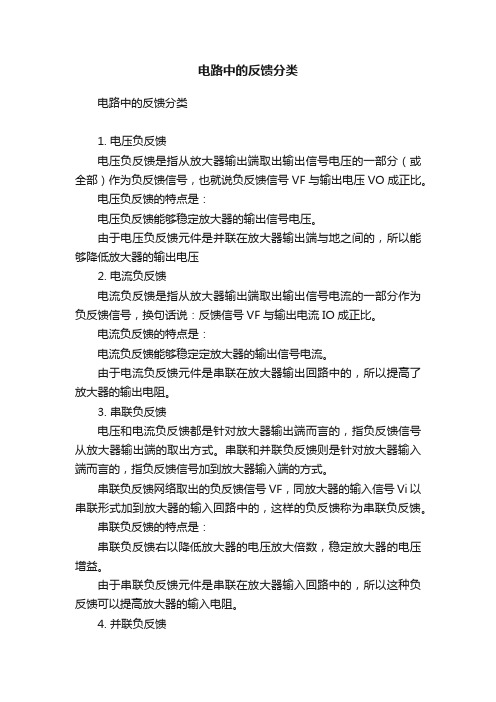
电路中的反馈分类电路中的反馈分类1. 电压负反馈电压负反馈是指从放大器输出端取出输出信号电压的一部分(或全部)作为负反馈信号,也就说负反馈信号VF与输出电压VO成正比。
电压负反馈的特点是:电压负反馈能够稳定放大器的输出信号电压。
由于电压负反馈元件是并联在放大器输出端与地之间的,所以能够降低放大器的输出电压2. 电流负反馈电流负反馈是指从放大器输出端取出输出信号电流的一部分作为负反馈信号,换句话说:反馈信号VF与输出电流IO成正比。
电流负反馈的特点是:电流负反馈能够稳定定放大器的输出信号电流。
由于电流负反馈元件是串联在放大器输出回路中的,所以提高了放大器的输出电阻。
3. 串联负反馈电压和电流负反馈都是针对放大器输出端而言的,指负反馈信号从放大器输出端的取出方式。
串联和并联负反馈则是针对放大器输入端而言的,指负反馈信号加到放大器输入端的方式。
串联负反馈网络取出的负反馈信号VF,同放大器的输入信号Vi以串联形式加到放大器的输入回路中的,这样的负反馈称为串联负反馈。
串联负反馈的特点是:串联负反馈右以降低放大器的电压放大倍数,稳定放大器的电压增益。
由于串联负反馈元件是串联在放大器输入回路中的,所以这种负反馈可以提高放大器的输入电阻。
4. 并联负反馈并联负反馈是指负反馈网络取出的负反馈信号VF,同放大大器的输入信号Vi以并联形式加到放大器的输入回路中,这样的负反馈称为并联负反馈。
并联负反馈的特点是:并联负反馈降低放大器的电流放大倍数,稳定放大器的电流增益。
由于并联负反馈元件是与放大器输入电阻相并联的,所以这种负反馈降低了放大器的输入电阻。
5. 负反馈电路种类负反馈电路在放大器的输出端和输入端之间,根据负反馈放大器输入端和输出端的不同组合形式,负反馈放大器共有下列四种电路:电压并联负反馈放大器电路;电压串联负反馈放大器电路;电流并联负反馈放大器电路;电流串联负反馈放大器电路;负反馈电路接在本级放大器输入和输出端之间时称为本级负反馈电路,当负反馈电路接在多级放大器之间时(在前级放大器输入端和后级放大器输出端之间),称为放大环路负反馈电路。
电流反馈运算放大器在高速I 转O中的应用
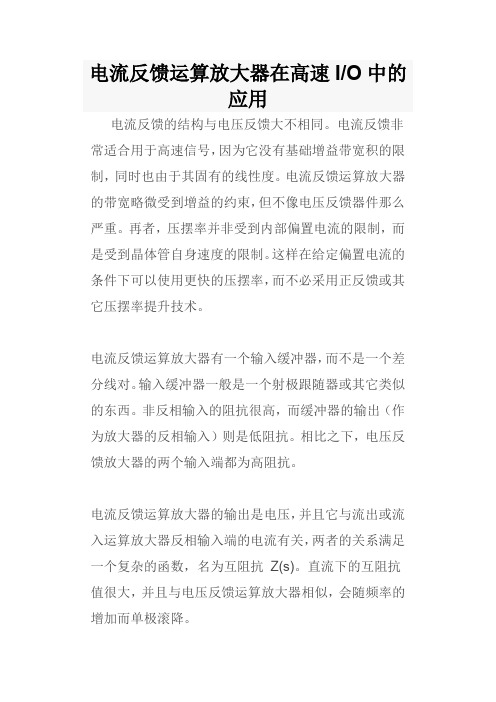
电流反馈运算放大器在高速I/O中的应用电流反馈的结构与电压反馈大不相同。
电流反馈非常适合用于高速信号,因为它没有基础增益带宽积的限制,同时也由于其固有的线性度。
电流反馈运算放大器的带宽略微受到增益的约束,但不像电压反馈器件那么严重。
再者,压摆率并非受到内部偏置电流的限制,而是受到晶体管自身速度的限制。
这样在给定偏置电流的条件下可以使用更快的压摆率,而不必采用正反馈或其它压摆率提升技术。
电流反馈运算放大器有一个输入缓冲器,而不是一个差分线对。
输入缓冲器一般是一个射极跟随器或其它类似的东西。
非反相输入的阻抗很高,而缓冲器的输出(作为放大器的反相输入)则是低阻抗。
相比之下,电压反馈放大器的两个输入端都为高阻抗。
电流反馈运算放大器的输出是电压,并且它与流出或流入运算放大器反相输入端的电流有关,两者的关系满足一个复杂的函数,名为互阻抗Z(s)。
直流下的互阻抗值很大,并且与电压反馈运算放大器相似,会随频率的增加而单极滚降。
图 1 - Z(s) 与反馈电阻RF.电流反馈运算放大器有可调带宽和可调整的稳定度。
反馈电阻设定了闭环动态范围,并且会同时影响带宽和稳定度。
电流反馈的一个最大优点就是有很好的大信号带宽。
基于反馈电阻的应用,有很高的压摆率和可调带宽,使器件的大信号带宽非常接近于小信号带宽。
并且,由于固有的线性度,高频大信号时也可以获得低的失真。
为什么RF 值如此重要?反馈电阻的闭环特性使我们能够避免固定增益带宽的限制。
这可以通过降低反馈电阻的值来实现,这样可以在提高增益的同时保持回路高增益。
图 2 - RF 对频率响应的作用图 2 是一个宽带视频放大器的实例。
可以看到改变反馈电阻时带宽的变化情况。
在曲线最右端RF 等于200 Ω,可以看到频率响应有相当大的尖峰。
尖峰幅度几乎有1/2 dB。
该曲线亦有最大的带宽。
当反馈电阻减小时,尖峰也进一步增加。
电阻减小至200 Ω 以下则很可能在脉冲响应上出现糟糕的振铃,如果电阻过低则会出现振荡。
电流反馈运放大器

7 电流反馈运放大器Erik Barnes,Analog Devices Inc.问:与普通运放相比,我不太明白电流反馈运放如何工作?我听说电流反馈运放带宽恒定,不随增益变化而改变,那是怎么实现的?它与互阻放大器是否一样?答:在考察电路之前,我们先给电压反馈运放(VFA)、电流反馈运放(CFA)和互阻放大器这三个概念下定义。
顾名思义,电压反馈是指一种误差信号为电压形式的闭环结构。
传统运放都用电压反馈,即它们的输入对电压变化有响应,从而产生一个相应的输出电压。
电流反馈是指用作反馈的误差信号为电流形式的闭环结构。
CFA其中一个输入端对误差电流有响应,而不是对误差电压有响应,最后产生相应的输出电压。
应该注意的是两种运放的开环结构具有相同的闭环结果:差动输入电压为0,输入电流为0。
理想的电压反馈运放有两个高阻抗输入端,从而使输入电流为0,用电压反馈来保持输入电压为0。
相反,CFA有一个低阻抗输入端,从而使输入电压为0,用电流反馈来保持输入电流为0。
互阻放大器的传递函数表示为输出电压对输入电流之比,从而表明开环增益Vo/Iin用欧姆(Ω)表示。
因此,CFA可称作互阻放大器。
有趣的是,利用VFA闭环结构也可构成互阻特性,只要用电流(如来自光电二极管的电流)驱动低阻求和节点,就可产生一个电压输出,其输出电压等于输入电流与反馈电阻的乘积。
更有趣的是,既然理想情况下,任何一个运放应用电路都可以用电压反馈或电流反馈来实现,那么用电流反馈也能实现上面的I V变换。
所以在用互阻放大器这一概念时,要理解电流反馈运放与普通运放闭环I V变换电路之间的差别,因为后者也可表现出类似的互阻特性先看VFA的简化模型(见图1),同相增益放大器电路以开环增益A(s)放大同相放大原理图波特图图1此主题相关图片如下:VFA的简化模型差模电压(V IN+ -V IN- ),通过RF和RG构成的分压电路把输出电压的一部分反馈到反相输入端。
为推导出该电路的闭环传递函数VO/V IN+ ,假设流入运放输入端的电流为0(输入阻抗无穷大);两个输入端民位近似相等(接成负反馈且开环增益很高)。
5-反馈和负反馈放大电路---模拟电子技术基础汇总全

R1
+
•
方
Ui –
•
Ii
•
Iid
放大电路
•
Xo
框 图
•
If
反馈网络
特点
反馈网络并联于输入回路 反馈信号为电流
上页 下页 返回
模拟电子技术基础
3. 负反馈放大电路的四种基本类型 a. 电压串联负反馈 方框图
+
•
+
•
A
U_i
•
U_id
+
•
U_f
•
F
+
•
U_o
RL
上页 下页 返回
模拟电子技术基础
b. 电压并联负反馈
中频时
1 Af= 1+AF
即 电路的闭环放大倍数是开环放大倍数的1/(1+AF)倍。 D=1+AF 称为反馈深度
上页 下页 返回
模拟电子技术基础
a. 放大倍数下降的原因
由于
X·id=X·i–X·f
X·f=F·X·o= F·A·X·id
故
X·id=
X·i 1+A·F·
即引入负反馈之后,电路的净输入信号降为原输 入信号的1/(1+AF) 。
R1
+
+
稳定输出电流
uI
_
_
_
iO
A
+
+
u_O
R2 R3
稳定输出电流的机理
Io
If
Iid
Io
上页 下页
返回
模拟电子技术基础
5.1.4 负反馈放大电路的一般表达式
.
.
03第三章运算放大器及反馈

第三章集成运算放大器及反馈集成化是电子技术进展的一个重要方向,集成运算放大器(简称集成运放)是模拟集成电路中品种最多、应用最普遍的一类组件。
反馈是一个很重要的概念,各类自动操纵,自动调剂系统都离不开反馈。
集成运放加上负反馈可组成各类模拟运算电路。
本章要紧介绍集成运放及其线性应用和反馈的概念。
本章学习目标:(1)明白集成运放的大体性能,熟悉集成运放符号;(2)明确“同相输入端”及“反相输入端”的含义;(3)会通过工具书查阅集成运放型号、参数、连接方式、利用注意事项等资料;(4)明确反馈的概念,明白反馈对放大电路的阻碍;(5)明白集成运放线性运用和非线性运历时的特点;(6)熟悉并能计算同相较例、反相较例及加法运算电路。
第一节集成运算放大器一、集成运放简介前面讲述的放大电路是由分立的三极管、二极管、电阻、电容等元件,借助导线或印制电路连接成一个完整的电路系统,称之为分立元件电路。
利用集成工艺,将电路的所有元件及联接导线集成在同一块硅片上,封装在管壳内,成为一个具有特定功能的完整电路即集成电路。
与传统的分立元件电路相较,集成电路具有体积小、重量轻、功耗小、本钱低、靠得住性好等优势。
因此电子设备中集成电路几乎取代了分立元件电路。
集成电路的品种很多,按其功能可分为模拟集成电路和数字集成电路两大类。
数字集成电路用于产生、变换和处置各类数字信号。
模拟集成电路用于放大、变换和处置模拟信号(模拟信号,是指幅度随时刻作持续转变的信号)。
模拟集成电路又称线性集成电路。
集成运放是一种模拟集成电路。
集成电路封装后通过引脚与外部电路联接,集成电路的外形有如图3-1所示的几种常见形式。
各类集成电路型号、管脚排列、大体联接方式及参数等等,有集成电路手册可供查阅。
图3-1 集成电路外形图例如集成运算放大器实质上是一种高增益、多级、直接耦合的放大器。
它的电压放大倍数可达104~107。
集成运放的输入电阻从几十千欧到几十兆欧,而输出电阻很小,仅为几十欧姆。
电流反馈运算放大器介绍及RF的作用

电流反馈运算放大器介绍及RF的作用电流反馈运算放大器(Current Feedback Operational Amplifier,简称CFOA)是一种特殊的运算放大器,其特点是使用电流而不是电压来进行输入和输出的放大。
相比传统的电压反馈运算放大器(Voltage Feedback Operational Amplifier,简称VFOA),CFOA具有更高的带宽、更快的响应速度和更低的失调电压。
同时,CFOA还具有更广泛的输入信号范围,能够应用于电流、电压以及混合信号的放大和处理。
CFOA主要由两个部分组成:输入电流放大器和电压传输放大器。
输入电流放大器主要负责将输入信号转换为电流信号,并放大到适当的水平。
电压传输放大器则将输入电流转换为电压输出信号,并进行放大。
CFOA的输入阻抗较高,输出阻抗较低。
这使得CFOA在电流传输方面具有很高的性能,能够提供更好的信号传输效果。
此外,CFOA还具有较低的失调电压、失调电流和温漂,使得其适用于高精度和高性能的应用。
CFOA在电子设计中有着广泛的应用,包括滤波器、模数转换器、运算放大器、比较器、交换电源、多路复用器等。
其中,CFOA在滤波器设计中具有很大的优势。
CFOA能够提供更高的增益带宽积,并具有较快的响应速度,使其能够设计出更高阶的滤波器,更好地满足实际需求。
RF是CFOA中的一个重要参数,表示反馈电阻。
RF的作用是为CFOA提供反馈路径,使得输入和输出之间的差异被修正。
通过调节RF的大小,可以改变CFOA的放大倍数和增益。
较大的RF会增大CFOA的增益,而较小的RF则会减小CFOA的增益。
通过调节RF的大小,可以实现对CFOA输出信号的调节和控制。
通过增大RF的大小,可以增加CFOA的放大倍数,从而提高输出信号的幅度。
而通过减小RF的大小,可以降低CFOA的放大倍数,实现输出信号的缩小。
此外,RF还能够对CFOA的频率响应进行调节。
通过选择合适的RF值,可以改变CFOA的频率特性,使其在一定频率范围内具有较为平坦的增益特性。
AD8011_300 MHz、1 mA电流反馈型放大器
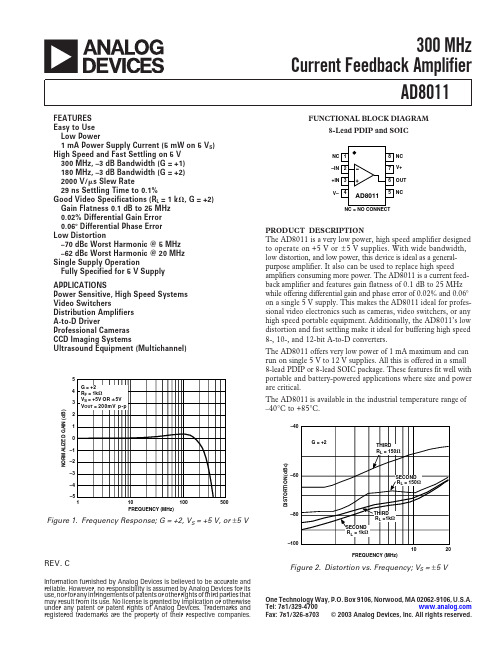
dB dB dB dB nV/√Hz pA/√Hz pA/√Hz % % Degrees Degrees ± mV ± mV µV/°C ±µ A ±µ A ±µ A ±µ A kΩ kΩ kΩ pF ±V dB ±V Ω mA mA V mA dB
TMIN–TMAX Offset Drift –Input Bias Current TMIN–TMAX +Input Bias Current TMIN–TMAX Open-Loop Transresistance TMIN–TMAX INPUT CHARACTERISTICS Input Resistance Input Capacitance Input Common-Mode Voltage Range Common-Mode Rejection Ratio Offset Voltage OUTPUT CHARACTERISTICS Output Voltage Swing Output Resistance Output Current Short-Circuit Current POWER SUPPLY Operating Range Quiescent Current Power Supply Rejection Ratio
Third Harmonic Input Voltage Noise Input Current Noise Differential Gain Error Differential Phase Error DC PERFORMANCE Input Offset Voltage
–75 –67 –70 –54 2 5 5 0.02 0.02 0.06 0.3 2 2 10 5 5 5 6 15 20 15 20
–40 G = +2
- 1、下载文档前请自行甄别文档内容的完整性,平台不提供额外的编辑、内容补充、找答案等附加服务。
- 2、"仅部分预览"的文档,不可在线预览部分如存在完整性等问题,可反馈申请退款(可完整预览的文档不适用该条件!)。
- 3、如文档侵犯您的权益,请联系客服反馈,我们会尽快为您处理(人工客服工作时间:9:00-18:30)。
Current Feedback Amplifiers National Semiconductor Corporation电流反馈放大器美国国家半导体公司Current Feedback Amplifiers声明:本文为中国电子网社区网友NE5532翻译,在翻译中得到了中国电子网和广大社区网友的帮助,在这里一并致谢。
本文仅供大家学习参考,并不得用于商业目的。
欲索取国家半导体公司的原版资料,请查询国家半导体网站模拟技术大学栏目。
西南科技大学(SWUST)江海波(NE5532)2004-7电流反馈放大器1. The Conventional OP Amp (6)2. Gain Bandwidth Tradeoff (10)3. Slew-Rate Limiting (13)4. The Current-Feedback Amplifier (16)5. No Gain-Bandwidth Tradeoff (22)6. Absence of Slew-Rate Limiting (25)7. Second-Order Effects (27)8. CF Applications Considerations (32)9. CF Integrators (34)10. Stray Input-Capacitance Compensation (36)11. 译注: (37)Current Feedback AmplifiersIn their effort to approximate the ideal OP amp, manufacturers must not only maximize the open-loop gain and minimize input-referred errors such as offset voltage, bias current, and noise, but must also ensure adequate band-width and settling-time characteristics. Amplifier dynamics are particularly important in applications like high-speed DAC buffers, subranging ADCs, S/H circuits, ATE pin drivers, and video and IF drivers (Reference 1)Being basically voltage-processing devices, OP amps subject to the speed limitations inherent to voltage-mode operation, stemming primarily from the stray capacitances of nodes and the cutoff frequencies of transistors. Particularly severe is the effect of the stray capacitances between the input and output nodes of high-gain inverting stages because of the Miller effect which multiplies the stray capacitance by the voltage gain of the stage.On the other hand, it has long been recognized that current manipulation is inherently faster than voltage manipulation. The effect of stray inductances in a circuit is usually less severe than that of its stray capacitances, and BJTs can switch currents much more rapidly than voltages. These technological reasons form the basis of emitter-coupled logic, bipolar DACs, current conveyors, and the high-speed amplifier topology know as current-feedback (Reference 2)For true current-mode operation, all nodes in the circuit should ideally be kept at fixed voltages to avoid the slow-down effect by their stray capacitances. However, since the output of the amplifier must be a voltage, some form of high-speed voltage-mode operation must also be provided at some point. This is achieved by employing gain configurations that are inherently immune from the Miller effect, such as the common-collector and the cascode configurations, and by driving the nodes with push-pull stages to rapidly charge/discharge their stray capacitances.To ensure symmetric rise and fall times, the NPN and PNP transistors must have comparable characteristics in terns of cutoff frequency. Traditionally,monolithics PNP’s have been plagued by much poorer performance characteristics than their NPN counterparts. However, the recent development of truly complementary high-speed processes makes it possible to achieve monolithics speeds that were hitherto available only in hybrid form. t fThe advantages of the current-feedback topology are best appreciated by comparing it against that of the conventional OP amp (Reference 3, Reference 4).电流反馈放大器在我们为实现理想OP放大器的努力中,生产商所要做的不仅仅是增大开环增益,减小输入相关的误差因素,例如失调电压、偏置电流,噪声情况,也应该确保足够带宽和建立时间特性。
在高速DAC和ADC系统、S/H(采样保持电路)、ATE(Automatic Test Equipment 自动测试系统)驱动器、视频系统和信号采集驱动器的应用领域,放大器的动态指标就显得尤为重要了。
(见参考文献1)作为一个电压处理型的器件,OP的速度被其内部特性所限制,主要是节点杂散电容和晶体管截止频率的瓶颈影响。
其中最严重的是杂散电容的影响,在作为高增益反相放大级使用的时候,杂散电容将造成输出和输入点之间的偶合,并且由于弥勒效应的影响,杂散电容的(效应)将被本级所放大。
另一方面,我们早就认识到,对电流信号处理的速度在本质上高于对电压信号的处理速度。
在电路中,杂散电感的影响比杂散电容要小得多;另外,三极管切换电流信号的速度也比切换电压信号要快得多。
以这些理论为支持,射极耦合器件、双极DAC、电流传送器,以及被称为电流反馈运放的高速运算放大器技术。
(见参考文献2)要想实现真正的电流处理,电路中的所有节点都应该保持在一个固定的电压上,以避免由于杂散电容带来的缓变现象。
但是,由于OP输出的必须是一个电压量,在一些节点上我们也要采用高速电压处理的措施。
采用一些在结构上能够避免弥勒效应的电路,如采用共集电极(射极跟随器)、共射——共基结构,采用推挽电路来驱动节点,以使得其能够对杂散电容迅速充电、放电。
为了确保上升时间和下降时间的对称性,推挽结构使用的NPN管和PNP管必须要有相匹配的性能参数,特别是截至频率f t。
在传统的单片IC中,PNP管的性能较其配对的NPN管低很多的情况一直困扰着我们。
但是,近期真互补高速工艺的发展,使得对管能够达到单片IC 的速度,但迄今为止,这仅限于混合模式中。
于传统模式的OP相比较,可以让我们更深入地了解电流反馈OP的优势所在(见参考文献3、参考文献4)。
Current Feedback Amplifiers1. The Conventional OP Amp传统运算放大器:The conventional OP amp consists of a high input-impedance differential stage followed by additional gain stages, the last of which is a low output-impedance stage. As shown in the circuit model of Figure 1A, the OP amp transfer characteristic isd o V jf a V )(=------- (1)Whereis the output voltage; o V n p d V V V −= is the differential inputvoltage; and , a complex function of frequency, is the open-loopgain. )(jf a t fConnecting an external network as in Figure 1b creates a feedback path along which a signal in the form of a voltage is derived from the output and applied to the non-inverting input. By inspection.o i d V R R R V V 211+−=------- (2)Substituting into Eq. (1), collecting, and solving for the ratio V yields thefamiliar non-inverting amplifier transfer characteristic i o V /)(/111)1()(12jf T R R V V jf A i o ++==∆------- (3)Where represents the closed-loop gain, and)(jf A电流反馈放大器12/1)()(R R jf a jf T +=-------(4)Represents the loop gain.The designation loop gain stems from the fact that if we break the loop as in Figure 2a and inject a test signal withsuppressed, the circuit will firstattenuate to produce x V i V x V 12/R R V xn =1+V and then amplify to producen VCurrent Feedback Amplifiersn o aV V −=/V o T . Hence, the gain experienced by a signal in going-around theloop is . The negative of this ratio represents theloop gain, )/1(12R R a V x +−=)/(x o V V −≡ Hence, Eq. (4).12/1R R +d V ∞→d p V o a V (a n V =V V −=The loop gain gives a measure of how closeA is to the ideal value, also called the noise gain of the circuit. By Eq. (3), the larger T ,the better. To ensure substantial loop gain over a wide range of closed-loop gains, OP amp manufacturers strive to makeA as large as possible.Consequently, will assume extremely small values since . Inthe limitwe obtain V , that is, . This forms thebasis of the familiar OP amp rule: when operated with negative feedback, an OP amp will provide whatever output voltage and current are needed to ideally force to follow . a V V o d /=0→p n V V →传统的运算放大器由一个高输入阻抗的差分放大器和一个高增益的放大级组成,其中放大级的末级为一个低输出阻抗的放大器。
